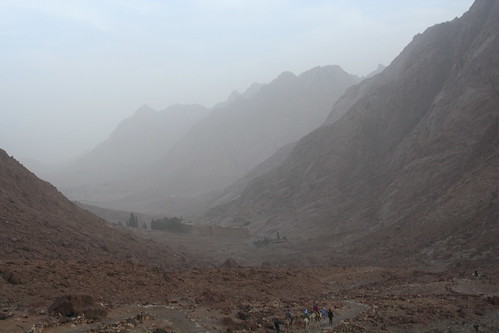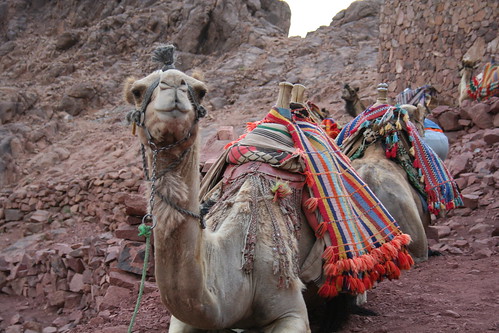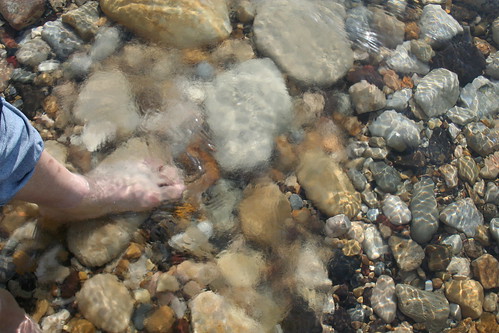Apu Ausangate: 5/1-7/2007

The best part about climbing this tall (6372 m, 20,905 ft) and revered Quechua Apu was sitting around the table in the kitchen tent after dinner and listening to our porters, two local men from the nearby village (Daniel and Adrian), tell stories of their sacred peak. The stories were told in Quechua, then translated into Spanish, then translated again into English... so, my re-tellings give the general idea, but have to be taken with a grain of salt. And, of course, Adrian said that when his grandpa tells the stories, they are much better.

This great, respected, and powerful Apu (god/mountain/person) is known by the locals as Hawan Qatteq. The Spanish took this name and changed it to Ausangate. The legends of this mountain hold it as a powerful protector of the Inca, now Quechua, people.
The Spanish were invading the Inca land and storming the city of Cusco. The Spanish were very powerful with their guns and cannons, the people only had clubs and waraka (ropes that you spin to throw rocks). So the people had to flee for their lives. They fled to Apu Hawan Qatteq, but the Spanish followed. The people hid behind the lake Yana Cocha,

behind the 'gate' into the apu, Afuera. The Spanish got to the gate, but unable to go further, they camped there. The people kept coming to Apu, fleeing the Spanish from all over. It was hard for so many people to hide from the Spanish, so they began to fight with them. The Spanish had guns, so many people started to die. They asked Apu for help. Suddenly, a very big man appeared on the summit. He had on a red poncho, and sat on a big white horse. He started charging down from the summit and toward the gate, and down with him came all the thunder and lightning. The thunder and lightning hit the Spanish and killed them all. The people were safe.
Ausangate is hollow in the center and there is water and a jungle and corn and quinoa and the spirit animals- puma, condor, and others - living in there. When the Spanish came, the people fled to Ausangate. They took all their riches, gold, corn, llamas, coca and put it all into the mountain. It is still there. The mountain is full of gold. There is only one way/gate in, and only one way/gate out.
The Spanish were invading the land of the people of the Andes (interestingly, they don't call themselves the Inca or the Quechua, they are the people of the Andes). The spirit llamas decided to help. The llamas had colorful strings on their ears and around their necks.

They tricked the Spanish into thinking they were people, and their friends. The Spanish looked at them and thought they were their friends. So they followed the llamas. The llamas led them to the gate of Ausangate. Again the large man with the red poncho on the white horse appeared. He rushed down from the summit toward the gate. Thunder and lighting came crashing onto the Spanish and killed them all. The Spanish were never able to pass the gate into Ausangate, and all the people who hid behind the great Apu were safe.
When the Apu distroyed the Spanish at the lake/gate (in) of Ausangate, all the guns were left on the ground. The people threw all the guns into the very center of the lake. They are still there. But if you go into the lake to get them... you can go in, but you cannot come out.
A few days before the stories at the dinner table, we hiked up to the lake, and past it; through the gate, and into the domain of Apu Hawan Qatteq. From there it was a two day hike, over passes lined with huge bright glaciers and steep rocky ridges.

I could feel the magic and power of this protected place as we made our way around it to the South side.
We made a base camp under the mountain's south face in a wide meadow. While setting up camp, a condor flew over us. Adrian was very excited about this... it was a good sign. At base camp, the horses with us grazed happily, and periodically (usually around meal time) kids, would pass by with their flocks of sheep and stare at the strange foreigners and ask for bread. Rod and I rested the next day, while the porters carried some of the gear up to the High Glacier Camp (5770 m, 18,925 ft). The following day we hiked up the long moraine ridge as far as possible, until hitting the snow. Then a long slog up snow to the base of 'the wall', a 100 m steep ice/snow section that we will begin our climb with tomorrow.

We pitched our tent in the High Camp on a narrow knoll framed by two deep crevasses. It was very cold. We ate an early dinner, set our alarms to wake us at midnight, and drifted into sleep.
BEEEEP!! BEEEEP!! Up. Cold. Breakfast. Cold. Crampons on. Cold. Headlamp and helmet. Cold. Tie into the ropes. Cold. Start walking. The morning started with cold (in case i didn't mention that) and then, the climb up 'the wall'. This was a calf tiring way to start the day; ~60 degree climb front pointing with two ice tools. But once we reached the top, the route to the summit was technically much easier.

We switched from our crampons to snow shoes and slowly made our way up the soft snow, dodging crevasses, toward the summit. Surprisingly, the altitude had little affect on us, we felt strong and solid trudging up. As we got closer to the summit, the snow conditions started to deteriorate.

Every year, the summit of Ausangate changes shape. The wind shifts the snow around, and the ice forms new blocks and features. No one knows what it will look like up there until you get there and see it. Standing at ~6350 m, 20,728 ft, about 60 m from the summit, the final ridge to the summit point was a very sketchy, unprotectable, totally exposed, windy walk of death. We decided not to walk the ridge of death, and call where we were the summit. Yes!! Apu Ausangate!! Standing there, i searched the ground for horse footprints, or maybe a red thread or two.

The Apu was very gentile with us, we felt strong, no accidents, no altitude sickness or even headaches, just a beautiful climb up a beautiful mountain. In thanks, we made the traditional offering to its spirit; coca, corn, and liquor, and started our decent. And here is the magical part... just down from the summit, Ausangate sent out the spirit animals to visit us. Really! The strangest mists appeared from the summit, and they formed into wispy clouds in the shape of Llama, Snake, Condor, Puma, and Dragon (I don't know what Dragon was all about). Now, usually I don't see shapes in the clouds... even if i try to. Cloud shapes are not precise enough, not exact enough. But the clouds coming off the summit of Ausangate were so sharp and precise that I saw the animals immediately, and without thought. The shapes were active and vibrant; moveing and gesturing as they drifted directly overhead. And it was not just clouds, we could feel that there was something special going on. The air was filled with a sense of welcome, of peace, of love.
This mountain is filled with gold; it has a heart of gold, truely a heart of gold.




 We gave our offering of water and started the walk down. We were sipping hot anniversary tea while walking down when a Bedouin camel jockey offered us camel rides. How could we pass that up?! He led us to his animals, and after scaryly standing up, we began a very painful and funny journey down the camel trail. The way they have the saddles; a big wooden post is cramming into your crotch as you ride! The gangly awkwardly moving camels clomp heavily down the rocky trail, and the jockey doesn't give any instruction on how to ride comfortably. Ouch!
We gave our offering of water and started the walk down. We were sipping hot anniversary tea while walking down when a Bedouin camel jockey offered us camel rides. How could we pass that up?! He led us to his animals, and after scaryly standing up, we began a very painful and funny journey down the camel trail. The way they have the saddles; a big wooden post is cramming into your crotch as you ride! The gangly awkwardly moving camels clomp heavily down the rocky trail, and the jockey doesn't give any instruction on how to ride comfortably. Ouch! 

 He looks at us like he can't imagine what we are doing there. We grab some water and start walking along the animal trails up the side of the mountain. Not really believing that we will find anything, we reach the summit and see the pillar bases and carved blocks of an ancient temple. The temple basically takes up the entire summit of this peak... we can only imagine how grand and impressive it was when it was standing.
He looks at us like he can't imagine what we are doing there. We grab some water and start walking along the animal trails up the side of the mountain. Not really believing that we will find anything, we reach the summit and see the pillar bases and carved blocks of an ancient temple. The temple basically takes up the entire summit of this peak... we can only imagine how grand and impressive it was when it was standing.  Rows of pillar bases surround a raised platform and altar. Much of the ground is flat, paved with rock squares. There are round fallen pillar pieces, carved roof blocks, and stones with engraved writing everywhere! Amazing! From the bottom you would never know this is up here!
Rows of pillar bases surround a raised platform and altar. Much of the ground is flat, paved with rock squares. There are round fallen pillar pieces, carved roof blocks, and stones with engraved writing everywhere! Amazing! From the bottom you would never know this is up here!
 We are in the Holy Land. We are following the route Moses was forbidden to travel by the King Edom (Numbers 20), and headed to the spot where Moses was given a view of the Promised Land (Deuteronomy 34:1) and where Moses was later buried, by the Hebrew God himself. The episode of Balak and Balam (2:13-26) also took place here.
We are in the Holy Land. We are following the route Moses was forbidden to travel by the King Edom (Numbers 20), and headed to the spot where Moses was given a view of the Promised Land (Deuteronomy 34:1) and where Moses was later buried, by the Hebrew God himself. The episode of Balak and Balam (2:13-26) also took place here. The whole place has an easy, holy, peaceful feel. An olive tree outside, one among many, was planted by the Catholic Pope John Paul II, to promote peace between the Muslim and Christian people.
The whole place has an easy, holy, peaceful feel. An olive tree outside, one among many, was planted by the Catholic Pope John Paul II, to promote peace between the Muslim and Christian people.  The inside is a simple stone walled chapel and alter, flanked by beautiful, nicely preserved tile mosaics depicting animals and various christian stories. Outside is a very interesting sculpture of a cross with a serpent twisted around it.
The inside is a simple stone walled chapel and alter, flanked by beautiful, nicely preserved tile mosaics depicting animals and various christian stories. Outside is a very interesting sculpture of a cross with a serpent twisted around it.

















